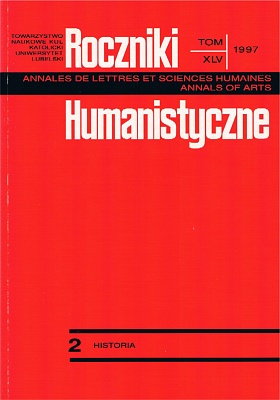Uposażenie ziemskie i nieruchomości prałatów kapituły kolegiackiej w Sandomierzu w XV-XVI w.
Abstrakt
The collegiate chapter in Sandomierz was erected in 1191. It was then that the collegiate Our Lady's church was consecrated. The point of interest here is the prelates of that chapter, especially their landed benefices and properties they owned in the 15th and 16th centuries. The source of information is Jan Długosz's Liber beneficiorum and The Book of Incomes of the Benefices from the Kraków Diocese of 1529 (the so-called Liber retaxationum).
The Sandomierz provostry, the highest office in the Sandomierz chapter, had one village. The deaconate, according to Długosz, had four villages pro sua dote; most probably one of them as a whole and in the remaining three it owned only some parts. The Sandomierz chanter owned as his property a town and a village. Individual sources of incomes from these places are accurately discussed in the Liber beneficiorum, however very often their money value is not stated. In the Liber retaxationum we find only the amounts of rents paid to the chanter, and similarly in the case of other prelates. Hence it is difficult, having the two sources, to compare the incomes the prelates gained from their benefices. A further prelate – the scholastic – owned three villages; he may have had two as a whole and obviously some parts in the remaining two. The curator, according to the Liber beneficiorum, owned parts of two places (in one he had two thirds, and in the other one fourth of the village). According to the Liber retaxationum, yet eight places were added to the other two, and the curator received rents.
The properties owned by the prelates of the Sandomierz chapter may be spotted only in Długosz's Liber beneficiorum; the Liber retaxationum quotes not information on that. Thus, according to Długosz, each of the prelates owned a house in Sandomierz; the location of the houses is relatively well defined. They were all made of wood, except for the provost's house, which was partly made of brick. The three prelates: archdeacon, chanter and scholastic also owned squares by their houses.
Now comparing the amounts of particular sources of income from the places which belonged to the prelates of the collegiate chapter in Sandomierz, we can state that, according to the Liber beneficiorum, the deacon had the highest income, whereas, according to the Liber retaxationum, the chanter had the highest income; the lowest income had the scholastic and the provost respectively. The balance sheet, however, does not have to be identical with the differences in the value of the very landed benefice. Undoubtedly, in the light of the Liber retaxationum it may be so, for we find here only information about the amount of the rents; in the light of the Liber beneficiorum it certainly cannot be identical, for one should bear in mind that all the remaining incomes paid to a given prelate from the village treated as his property, although these incomes had not been assessed. Accordingly, we cannot compare them with the rents presented in the form of concrete money benefits.
Copyright (c) 1997 Roczniki Humanistyczne

Utwór dostępny jest na licencji Creative Commons Uznanie autorstwa – Użycie niekomercyjne – Bez utworów zależnych 4.0 Międzynarodowe.





